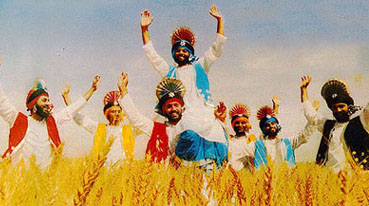Male Dress:
Men of Punjab like to wear their traditional attires that includes kurta pyjama. They wear kurta like shirt; it is a loose shirt that is straight cut and long. Their pyjamas are very loose; it is like baggy pants that are tied to waist. Few men too wear kurta over tehmat or loongi, it contains resemblance to sarong. While winter season, you will get to see Punjabi people wear dark fresh colorful sweaters. Few Punjabi boys and also men wear loose slacks or pants with t-shirt or collared shirt. You can easily identify Sikh people by their costumes, due to their religious customs they always wear turbans called as pugs. They also wear Punjabi traditional shoes that are known as Juttis, it is very famous among the men of urban and rural areas. They feel very comfortable in their attire and they also look very impressive in this costume. If you observe the modern city Punjabi males, you will get to know that as per the change in time their dressing pattern has been so much changed. They have also accepted western dressing style and they are equally feeling comfortable in modern t-shirt and jeans as they feel in kurta and loongi. On the special occasions, they also like to wear trousers and shirts. Punjabi males always look impressive in their traditional attires; in those attires their personality gets enhanced.
PUNJABI JUTTI FOR MEN
Female Dress:
The famous, convenient and comfortable dress worn through this state’s women is known as churidar Kurta. Traditionally, this type of dress is only worn by Punjab state's women, but in present time, it is also worn by other state's people. Majorly young generation prefers to wear this comfortable attire. Punjab state's women and girls too dress in salwar kameez of fresh and bright colors, accompanied by attractive and silky duppattas. Their salwar kameez has been distinguished in 2 pieces such as top piece or shirt and kameez & salwaar. The duppatta, which they wear over the salwar kameez is majorly a shining fabric which females mostly wear over their shoulders and over the head. You will also get to see women wearing shawls that have been decorated by using intricate phulkari designs. Their shawl is entirely wrapped in folk motis and large silk embroidery created in jewel tones.
PUNJABI JUTTI FOR WOMEN
PARANDI











.jpg)






















